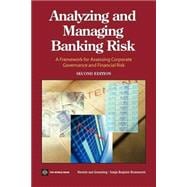
Note: Supplemental materials are not guaranteed with Rental or Used book purchases.
Purchase Benefits
What is included with this book?
| Foreword to the Second Edition | xiii | ||||
| Acknowledgments | xv | ||||
| 1 Analyzing and Managing Banking Risk | 1 | (14) | |||
|
1 | (2) | |||
|
3 | (2) | |||
|
5 | (3) | |||
|
8 | (3) | |||
|
11 | (4) | |||
| 2 A Context for the Risk-Based Review of Banks | 15 | (16) | |||
|
15 | (2) | |||
|
17 | (1) | |||
|
18 | (6) | |||
|
24 | (3) | |||
|
27 | (4) | |||
| 3 Key Players in the Corporate Governance and Risk Management Process | 31 | (28) | |||
|
31 | (2) | |||
|
33 | (2) | |||
|
35 | (3) | |||
|
38 | (2) | |||
|
40 | (6) | |||
|
46 | (5) | |||
|
51 | (2) | |||
|
53 | (3) | |||
|
56 | (3) | |||
| 4 Balance Sheet Structure and Management | 59 | (22) | |||
|
59 | (3) | |||
|
62 | (5) | |||
|
67 | (5) | |||
|
72 | (4) | |||
|
76 | (5) | |||
| 5 Profitability | 81 | (20) | |||
|
81 | (2) | |||
|
83 | (6) | |||
|
89 | (7) | |||
|
96 | (1) | |||
|
97 | (4) | |||
| 6 Capital Adequacy | 101 | (34) | |||
|
102 | (2) | |||
|
104 | (4) | |||
|
108 | (5) | |||
|
113 | (8) | |||
|
121 | (2) | |||
|
123 | (7) | |||
|
130 | (5) | |||
| 7 Credit Risk Management | 135 | (32) | |||
|
135 | (1) | |||
|
136 | (4) | |||
|
140 | (2) | |||
|
142 | (4) | |||
|
146 | (5) | |||
|
151 | (3) | |||
|
154 | (5) | |||
|
159 | (5) | |||
|
164 | (3) | |||
| 8 Liquidity Risk Management | 167 | (22) | |||
|
167 | (2) | |||
|
169 | (3) | |||
|
172 | (3) | |||
|
175 | (2) | |||
|
177 | (4) | |||
|
181 | (1) | |||
|
182 | (7) | |||
| 9 Treasury Organization and Risk Management | 189 | (32) | |||
|
189 | (3) | |||
|
192 | (7) | |||
|
199 | (2) | |||
|
201 | (6) | |||
|
207 | (6) | |||
|
213 | (8) | |||
| 10 Management of the Stable Liquidity Investment Portfolio | 221 | (10) | |||
|
221 | (2) | |||
|
223 | (1) | |||
|
224 | (1) | |||
|
224 | (1) | |||
|
225 | (1) | |||
|
225 | (2) | |||
|
227 | (1) | |||
|
228 | (1) | |||
|
229 | (2) | |||
| 11 Market Risk Management and Proprietary Trading | 231 | (18) | |||
|
231 | (3) | |||
|
234 | (3) | |||
|
237 | (3) | |||
|
240 | (4) | |||
|
244 | (2) | |||
|
246 | (3) | |||
| 12 Interest Rate Risk Management | 249 | (12) | |||
|
249 | (3) | |||
|
252 | (1) | |||
|
253 | (5) | |||
|
258 | (3) | |||
| 13 Currency Risk Management | 261 | (20) | |||
|
261 | (2) | |||
|
263 | (7) | |||
|
270 | (4) | |||
|
274 | (7) | |||
| 14 Transparency in the Financial Statements of Banks | 281 | (16) | |||
|
281 | (2) | |||
|
283 | (2) | |||
|
285 | (5) | |||
|
290 | (3) | |||
|
293 | (4) | |||
| 15 The Relationship between Risk Analysis and Bank Supervision | 297 | (26) | |||
|
297 | (1) | |||
|
298 | (6) | |||
|
304 | (3) | |||
|
307 | (7) | |||
|
314 | (5) | |||
|
319 | (4) | |||
| Appendixes | |||||
|
323 | (36) | |||
|
359 | (6) | |||
|
365 |
The New copy of this book will include any supplemental materials advertised. Please check the title of the book to determine if it should include any access cards, study guides, lab manuals, CDs, etc.
The Used, Rental and eBook copies of this book are not guaranteed to include any supplemental materials. Typically, only the book itself is included. This is true even if the title states it includes any access cards, study guides, lab manuals, CDs, etc.